ifs飞秒激光系统英文介绍资料 ppt课件
飞秒激光 PPT课件

而“一致性”指的是,假如预先设定要制作的板层角膜瓣厚度相同,则每次实际得 到的角膜瓣厚度均非常接近,波动幅度很小, 重复性很好。
• Holzer等用飞秒激光给45只新鲜猪眼制作角膜瓣,预先设置的角膜瓣切割
深度分别为120um、140um和180um,角膜瓣直径大小从8.0mm到 9.5mm,角膜瓣边缘切口角度从60°到90°。结果显示,所有角膜瓣制作 均完好无并发症,上述三种预设值最终取得的厚度分别为110.5um、 142.5um和180um,取得的角膜瓣直径为8.0mm到9.5mm,波动范围仅 /-0.4um,显示出极高的精确度和一致性。
(2)、由于飞秒激光制作角膜瓣是在计算机的精确控制下完成的,而且还有压 力感应安全自动保护装置,既能极精确地制作角膜瓣,又具有极高的安全性。不 少文献报道,飞秒激光制作板层角膜角膜瓣几乎不会发生与角膜瓣相关的严重并 发症,例如,游离角膜瓣、扭扣瓣、碎瓣、破裂瓣、过厚或过薄瓣等[2];更少发 生角膜上皮的损伤[9]。对角膜表层神经神经丛的破坏较小[10],因而,能减少手 术后干眼症状的发生。
(2)、由于飞秒激光与机械性微型角膜板层刀制作板层角膜瓣的原理完全不同: 飞秒激光制作角膜瓣时使用压平锥镜,首先将具有一定曲度的角膜压平,使之完 全呈水平面状态,根据预先设计的要制作的角膜板层厚度,将飞秒激光聚焦在角 膜表面与锥状压平镜接触处下方相应深度的角膜基质内,通过扫描切割精确制作 出所需要各种不同参数的板层角膜瓣。与机械性角膜板层刀不同,飞秒激光制作 板层角膜瓣完全不受角膜曲率的影响,无论角膜曲率高低,均能安全、精确地完 成角膜瓣的制作
1、飞秒激光制作板层角膜瓣的优点
飞秒激光简介
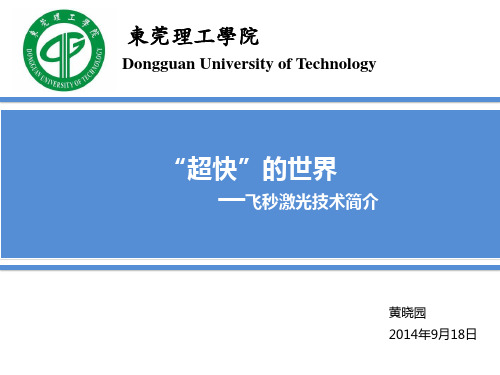
東莞理工學院
Dongguan University of Technology
光电信息工程技术研究开发中心
二、中心概况——研究平台
1、 LED研发与检测平台
具有LED灯具及显示屏的设计与性能检测等领域的仪器
包括积分球、光色电分析系统、LED电源自动测试系统、GO1900L灯具配光曲线测试系统
承担广东省战略性新兴产业项目1项,与东莞多家LED企业进行产学研合作
光电信息工程技术研究开发中心
二、激光及其历史
3、结构及其原理
工作物质 :提供增益介质 泵浦源:使介质出现粒子反转 谐振腔:增大激光能量
東莞理工學院
Dongguan University of Technology
光电信息工程技术研究开发中心
二、激光及其历史
3、结构及其原理
案例:激光笔结构图
三、飞秒激光及其发展
2、飞秒激光的发展 2000年,维也纳技术大学、加拿大国家研究中心和比利斐尔德大学的 研究人员组成了国际课题组 首次报道了他们产生的单个脉冲为650as(10-18s)的X光脉冲。
阿秒脉冲宽度
東莞理工學院
Dongguan University of Technology
光电信息工程技术研究开发中心
Dongguan University of Technology
光电信息工程技术研究开发中心
目录
一、研发中心概况 二、激光及其历史 三、飞秒激光及发展
四、飞秒激光特点与作用
東莞理工學院
Dongguan University of Technology
光电信息工程技术研究开发中心
一、中心概况—中心简介
积分球
光色电分析系统
iFS飞秒激光角膜手术仪参数

A包技术要求激光角膜手术仪一、设备名称、数量:激光角膜手术仪1台二、技术要求1.激光类型:锁模二极管泵浦Nd:glass激光*2.光斑直径:≤3 µm3.光束分散:≥0.31sr(+0.05sr)*4.脉冲重复频率:≤150KHz5.扫描模式:光栅和螺旋双模式6.脉冲持续时间: 600-800fs (+50fs)7.最大激光脉冲能量:≤2.5(±0.5µJ)8.最大激光脉冲峰值功率:≤4.2MW(+0.8MW)*9.激光波长:≥1053nm10.9mm角膜瓣制瓣最少时间:≤8秒11.角膜瓣厚度: 90~400um,12.OBL 解决方案:囊袋式13.厚度设置:以1um增减14.边切角度: 30~150°,15.边切角度设置:以 1°增减16.角膜瓣直径: 5.0~9.5mm,17.角膜瓣直径设置:以0.1mm增减18.瓣蒂控制(Hinge) : 45~90°,19.制瓣过程是否可见:全程可见SIK制瓣功能:有*21.可制作椭圆瓣有22.角膜基质隧道功能标配23.辅助角膜移植功能标配24.白内障临床应用功能可升级25.角膜透明切口功能可升级26.显微镜系统:高清晰视频显微镜27.操作系统:具有中文界面操作系统28.显示屏:二个高清彩色压力式触摸屏29.环境操作温度: 19ºC至23ºC(67ºF至73ºF)30.环境操作湿度: 35%-65%(非冷凝状态)31.整机移动性:可随时移动32.和准分子设备联机:能够配合准分子设备手术床做治疗33.认证:具有FDA、CE和SFDA 认证34.设备状态:全新设备,未使用过。
35.辅助检查床:有36.手术影像系统:有三.商务要求1.交货期:签订合同后60天。
2.质保期:设备自验收后原厂质保二年。
3.开放设备数据接口,免费提供数据接口连接采购人的相关信息系统。
4.免费提供产品商检报告.5.免费提供产品中文说明书.6.免费提供技术培训:保证操作使用人员熟练掌握设备的各种功能和日常维护保养,制定设备的技术操作规程和保养规程.免费培训医学工程人员一名(省内外均可),保证其熟练掌握维护保养及基本维修技能.并为其颁发培训证书。
激光矫正视力手术(English)(1)精选教学PPT课件
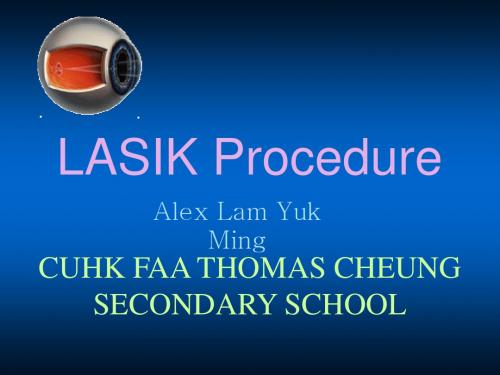
Short-sighted
In a nearsighted (myopic) eye, light rays from objects are focused in front of the seeing tissue of the eye (the retina), causing images - particularly at distance - to be blurred.
LASIK Procedure
Alex Lam Yuk Ming
CUHK FAA THOMAS CHEUNG SECONDARY SCHOOL
What is LASIK ?
L aser A ssisted in-SI tu K eratomileusis
Normal Refraction
To see clearly, light rays are focused on the retina by both the cornea (clear front portion of the eye) and the lens of the eye.
Microkeratome Cutting Position 1
A suction ring is placed on the eye and a microkeratome placed in the track of the suction ring. As the blade of the microkeratome moves across the cornea, a flap of corneal tissue, about one third depth is created with an operokeratome Cutting Position 2
飞秒激光 近视手术PPT课件
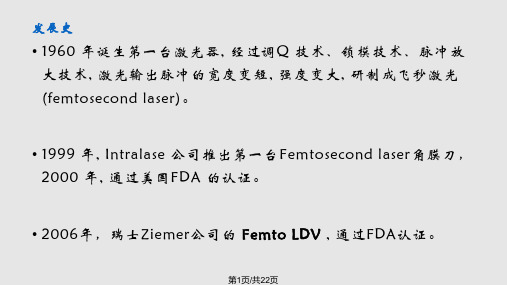
飞秒激光的原理
• 通过分子级的光爆破可以得到手术作用效果 • 无热效应或冲击波影响周边组织
• 激光脉冲的精确度可以精确到 (± 5 微米) • 电脑控制的光学传输系统产生成万的激光脉冲,用于做角膜瓣,切口, 薄片切除、角膜
切除
作用能量 = 能量/时间 通过相对低的能量得到很高的能量
第17页/共22页
飞秒激光制瓣的优点
• 更安全 • 降低负压的使用 • 避免交叉感染
• 角膜瓣厚度、直径可控性
• 角膜瓣术后反应轻 • 术后干眼症 • 减术后散光和高阶像差, 提高术后视觉质量
第18页/共22页
局限性
• 术中需要两种激光 • 费用昂贵:
USA 6000~8000 US dollar 港台 2~3万港币 大陆 16000~8800元
400 nm
紫外线
可视光
700 nm
FS
红外线
100,000 nm
第3页/共22页
飞秒激光的原理
• Femtosecond laser( 飞秒激光)
– (Nd:Glass) 1053 nm (近红外光)
• 每一个脉冲激光的聚焦持续 500-800 femtoseconds(10-15 秒 )
1秒钟时间,激光传输距离相当 于绕地球7.5圈 100个飞秒的时间, 激光的传输 距离为人的头发丝
第5页/共22页
光爆破的原理
激光精确的聚焦在在角膜内的一个位置
第6页/共22页
光爆破的原理
数千万ห้องสมุดไป่ตู้激光脉冲连接一起
第7页/共22页
光爆破的原理
当角膜瓣掀开时,气体和水被吸收或释放出来。
形成一个分开的平面
ifs飞秒激光系统英文介绍资料

New IntraLase Technology 5th Generation Femtosecond Laser
HIGHLIGHTS: • Inverted “Bevel-In” Side Cut Angle • Elliptical Flap Option • Higher Repetition Rate • Tighter Spot Separation, Lower Energy • Virtually Effortless Flap Lift • Lower Incidence of OBL in Initial Clinical Experience (Chayet)
Inverted Bevel-in Side Cut Angle嵌入型边切角:
• Better wound healing for enhanced biomechanical stability of the post LASIK cornea1,2 • Significantly stronger flap adhesion post-operatively for improved wound healing2 • Virtually effortless flap lift, replacement, and positioning for maximum flap stability3,4 • Significantly reduced flap gutter3
– Less OBL observed (less than 10% overall) – OBL was soft and typically dissipated immediately upon flap lift
飞秒激光在屈光手术中的应用优秀课件
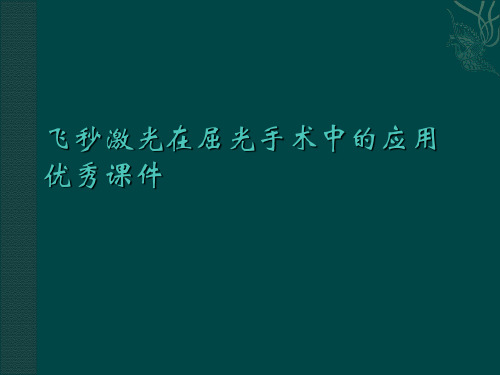
1飞秒只有1秒的一千万亿分之一,即 1e−15秒或0.001皮秒(1皮秒是,1e−12秒)。
每一个脉冲激光的焦点持续 10-15 秒
飞秒激光的特点
脉冲的方式发射能量,持续时间非常短, 不产生热效应
由于能量作用与时间成反比,故飞秒激光具 有极高瞬时功率
能聚焦很大的能量到极小的空间区域,进 行微精细切割
飞秒激光与角膜组织间是一种光致分解作 用
飞秒激光对角膜的作用原理
飞秒激光能在非常短的时间里聚焦于组织内极狭 小的空间,使组织电离并形成等离子体。
等离子体产生的电磁场强度比原子核对其周围电 子的作用力还大数倍,使组织发生光裂解
爆破产生含CO2 和水的微小气泡,成千上万紧密相 连的激光脉冲产生数以万计的小气泡连在一起
结论:飞秒激光是方向
LDV 飞秒激光
瑞士Ziemer公司
飞秒激光手术占总体 手术的90%以上
极致的高深是简单
——达芬奇
Z-LASIK飞秒激光手术
技术优势(高频,低能):
最快速的飞秒激光: 脉冲频率> 1 MHz 最小的点爆破空间< 2x2x2 µm 最低的单脉冲能量(<100nJ) 超短的脉冲时间 ~250 femtoseconds
原因: 媒体片面炒作 社会公信力缺失 最重要的是:患者对手术安全性的担心
Lasik手术安全性和有效性
Lasik手术 关键操作
如何完成一例完美的Lasik手术? 角膜瓣的制作 准分子激光切削
如何避免手术中并发症的发生? 角膜瓣并发症的发生率? 游离瓣、碎瓣、纽扣瓣、不完全瓣、角膜
电离辐射
热辐射
飞秒激光简介英文版
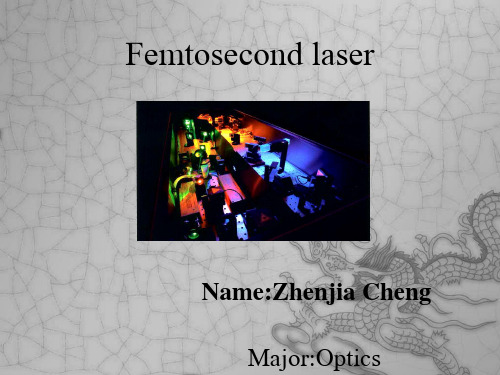
High-power femtosecond laser system
This is the highest intensity China currently available for experiments
Femtosecond laser
Name:Zhenjia Cheng Major:Optics
outline
1、FRealization method 3、Characteristics 4、Specific application
1、Fundamental conception
4、Specific application
1--Ultra-high-speed measurement 2--Femtosecond laser micromachining 3--Life Medical Treatment of myopia
4--Other Applications
Internationally available ultrashort laser device
Ti:sapphire
Ti:s/Nd:glass Ti:sapphire Nd:glass Ti:sapphire Ti:sapphire Ti:sapphire Ti:sapphire
50fs
500 fs 100fs 300fs 25fs 30fs 40fs 34fs
5J
500 J 20J 30J 2.5J 8.7J 10.8J 4.3J
Mankind under laboratory conditions to obtain Short pulse:10-15 s the shortest pulse techniques Is larger than the High peak power:1015W world's total power generation Accurate targeting Focus Small focused spot:m Magnitude Focusing power density:1020~1022W/cm2 The strength of the electromagnetic field around its nucleus than electrons in force even higher multiples
飞秒激光加工技术 PPT课件

最重要的特征。激光在极短的时间和极小的空间内 与物质相互作用,作用区域内的温度在瞬间内急剧 上升,并以等离子体向外喷发的形式得到去除。严 格避免了热熔化的存在,大大减弱和消除了传统加 工中热效应带来的诸多负面影响。
3)加工过程的准确性
每一个激光脉冲与物质相互作用的持续期内避免了 热扩散的存在,在根本上消除了类似于长脉冲加工过 程中的熔融区、热影响区、冲击波等多种效应对周 围材料造成的影响和热损伤,将加工过程所涉及的 空间范围大大缩小,从而提高了激光加工的准确程 度,即运用飞秒加工决不会“伤及无辜”。
长脉冲激光加工过程
飞秒脉冲激光加工过程
4)加工尺寸的亚微米特性和3D空间分辨性 飞秒加工可以突破光束衍射极限的限制,实现尺寸
小于波长的亚微米或纳米操作;
只有在材料的聚焦点才能获得较高的功率密度,从 而使得飞秒加工过程具有严格的空间定位选择能力。
5)加工能量的低耗性
脉冲持续时间非常短,能量在时间上高度集中例如,用 10 fs脉冲宽度的激光,0.3 mJ能量就可以在直径为2Lm 的焦点达到1018W/cm2的峰值强度,而用脉宽宽度为 10 ns的长脉冲激光,则要300 J的能量才能达到同样的 峰值强度。因此飞秒激光加工所需的脉冲能量阈值 一般为毫焦耳或微焦耳量级,较传统激光加工消耗的 光能量大大降低。
得非常脆弱,传统的机械切割技术已不太适用,成熟的化 学或等离子刻蚀对加工形状和结构的选择有限定,长脉冲 激光也很难实现对硅的加工。飞秒激光以其独特的除热和 消机械应力的加工特性给硅材料的切割等处理技术带来了 新的希望。
2003年加拿大科学家M.Meunier 等人采用光谱物理公司生产的重 复率为1KHz的钛宝石再生放大系 统,将输出波760~820nm 能量约 1mJ持续时间小于120fs的脉冲激 光对厚度仅为50um的硅晶片实现 了高精度切割。如图右。
飞秒激光器详解

飞秒激光器是仅以千兆分之一秒左右的超短时间放光的“超短脉冲光”发生装置。
飞是国际单位制词头飞托(f em t o)的缩写,1飞秒=1×10^-15秒。
所谓脉冲光是仅在一瞬间放光。
照相机的闪光的发光时间是1微秒左右,所以飞秒的超短脉冲光只有其10亿分之一左右的时间放光。
众所周知,光速是以30万千米每秒(1秒间绕地球7周半)无与伦比快的速度飞驰而过,但是在1飞秒期间连光也只不过前进了0.3微米。
通常,我们用闪光摄影能够剪下活动物体的瞬间状态。
同样如果用飞秒激光器闪光,则连以剧烈速度进行化学反应的过程,都有可能看到其反应的每个片断。
为此,可以使用飞秒激光器来研究化学反应之谜。
一般的化学反应是在经过能量高的中间状态,即所谓的“活性化状态”后进行。
活性化状态的存在早在1889年已由化学家阿雷尼厄斯从理论上预言,但是因为是在极短瞬间存在,所以无法直接地观察。
但是1980年代末通过飞秒激光器直接证明了它的存在,这是用飞秒激光器查明化学反应的一个例子。
如环戊酮分子经活性化状态分解为一氧化碳与2个乙烯分子。
现在飞秒激光器还应用于物理、化学、生命科学、医学、工程等广泛领域,特别是光与电子携手,期待在通信或计算机、能源领域开辟各种新的可能性。
这是因为光的强度几乎可以毫不损耗地从一地到另一地传输大量信息,使光通信进一步高速化。
在核物理学的领域,飞秒激光器带来了巨大冲击。
因为脉冲光具有非常强的电场,在1飞秒内有可能将电子加速到接近光速,所以,能够用于加速电子的“加速器”。
在医学上的应用如上所述,在飞秒内的世界连光都被冻结得无法前进很远,但是即使这个时间尺度,在物质中的原子、分子以及计算机芯片内部的电子在电路内依旧运动。
如果使用飞秒脉冲就能让其瞬间止住,研究发生了什么。
除了闪光让时间止住外,飞秒激光器还能够在金属上钻出直径最小达200纳米(万分之二毫米)的微孔。
这意味短时间内被压缩锁定在里面的超短脉冲光获得超高输出的惊人效果,而且对周围不产生额外损伤。
国外飞秒激光教材评介

国外飞秒激光教材评介张心正涂成厚(南开大学物理学院天津 300071)摘要飞秒激光是新的科学技术分支,目前国内还没有较全面的飞秒激光教材。
本文对国外相关教材《Femtosecond Laser Pulses – Principlesand Experiments》的主要内容、特点等几个方面对其进行了介绍和点评。
关键词飞秒激光激光外国教材飞秒激光(Femtosecond Laser)是八十年代初期诞生并迅速发展起来的激光前沿研究领域和新的科学技术分支。
近二十年来,从染料激光器到克尔透镜锁模的钛宝石飞秒激光器,以及后来的二极管泵浦的全固态飞秒激光器和飞秒光纤激光器,飞秒激光得到了广泛的发展。
Claude Rulliere的《Femtosecond Laser Pulses – Principles and Experiments——飞秒激光脉冲–原理和实验》(Springer 2005)是一本优秀的飞秒激光方面的英文教材,国内外许多大学将此书作为教材,这是一本值得关注、研究的物理学名著。
1.飞秒激光研究的意义和该书的写作背景飞秒激光的发展与超快过程的探测息息相关,它为我们提供了一种时间分辨率高达10-15 秒的光探针,使得我们有可能了解原子、分子的结构及其超快运动过程。
通常的规律是:能探测运动过程的速度越高,对微观世界在空间的认识上则越细微。
因此可以说,获得的激光脉冲宽度越窄,能促使我们研究物质微观世界的层次也就越深。
这样,用超快技术研究超快过程成了超快光子学的主要任务之一。
目前,对超快过程的研究表现最为活跃的方面有:飞秒半导体物理、飞秒化学中分子动力学过程、生物光合作用的超快过程、飞秒光电子技术、飞秒光谱全息技术、光层析(OCT)及光子成像技术。
由于飞秒激光所具有的超短、超强和高分辨率等特性,在医学、超精细微加工、高密度信息储存和记录等方面,飞秒激光都有着很好的发展前景,新的应用领域也变得日益成熟。
Ziemer瑞士达芬奇飞秒激光全面介绍

瑞士达芬奇飞秒激光一、手术概述达芬奇飞秒激光全称为Ziemer Femto Laser Doppler Velocimetry,也被简称为LDV 飞秒激光、ziemer飞秒激光或Z-lasik飞秒激光,是使用飞秒激光治疗近视的一种手术设备,也是目前该领域最先进的设备。
了解飞秒激光:飞秒(femtosecond)也叫毫微微秒,简称fs,是标衡时间长短的一种计量单位,飞秒激光是人类目前在实验室条件下所能获得最短脉冲的技术手段。
飞秒激光在瞬间发出的巨大功率比全世界发电总功率还大。
飞秒激光具有快速和高分辨率特性,它在病变早期诊断、医学成象和生物活体检测、外科医疗及超小型卫星的制造上都有其独特的优点和不可替代的作用。
用飞秒激光进行手术,没有热效应和冲击波,在整个光程中都不会有组织损伤。
二、手术优势1、小光斑、低能量:对周围组织影响最小,切削面产生的气泡最小;2、掀瓣后气泡立即消失:无需等待立即进入准分子手术程序;3、角膜瓣厚度均一:提高术后修复速度及术后视觉质量;4、不残留任何组织连接:角膜瓣能轻松掀起;5、角膜瓣及角膜基质表面光滑:术后快速修复并获得良好术后视功能;6、眼位固定稳定:杜绝吸引丢失及其它预料之外的结果;7、操作便利:Ziemer飞秒激光适配任何准分子激光设备,患者仅需躺在准分子手术台上即可接受飞秒激光手术,无需转换手术床位;8、应用范围广:既可用于准分子激光手术角膜瓣制作,也可完成板层角膜移植及角膜下基质环植入所需的角膜瓣切削。
9、大幅降低手术风险:在传统板层刀手术中,如果刀片旋转过程中发生负压环松脱等意外,角膜瓣的制作将彻底失败,手术只能等三个月以后再做,给患者和医生带来极大的心理压力。
而“飞秒激光”手术如出现类似意外的情况,医生只需将负压环再次戴上,立即补充激光即可,不需中断手术。
因为飞秒激光在制作角膜瓣时,只产生一些水和气泡推开角膜组织,对组织无损伤,可对同一患处进行多次手术,安全性大大提高。
现代激光技术6

E(t ) + E(t − τ )
[E(t) + E(t − τ )]
Delay Mirror New terms
IA (τ ) ≡
(2)
∫
∞
[E(t) + E(t − τ )]
2 2
dt
−∞
IA (τ ) ≡
(2)
∫
∞
E (t) + E (t − τ ) + 2E(t )E(t − τ )
2 2
2
This pulse sums with the blue part of the chirped pulse.
ω0
τ
This pulse sums with the green part of the chirped pulse.
τ t
t
SI on these two pulses yields the difference in spectral phase at nearby frequencies (separated by δω). This yields the spectral phase.
How SPIDER works
Input pulses
Chirped pulse t
Output pulses Two replicas of the pulse are produced, each frequency shifted by a different amount.
ω 0 + δω
超短脉冲的测量Ⅰ:自相关法
Outlines
Intensity Autocorrelation Single-shot autocorrelation Third-order Autocorrelation Intensity Cross-Correlation Interferometric Autocorrelation
飞秒激光手术教育课件

术中
1、麻醉术眼。手术开始时,先点麻醉眼药水。用专门的麻醉药 滴在眼球上,让它失去痛觉,但是触觉还是会存在。
2、制角膜瓣。首先,由开睑器帮助患者在整个激光治疗近视手 术过程中睁眼。然后医生给撑开的眼球装上吸环,用来制作角膜 瓣。过程只有数秒,患者可能会感到眼球有压迫感,或者短暂的 视力下降、黑蒙感和一些疼痛。
6、术后视力在1-3个月内可能会有所波动,而且有人会出现看近模糊看远清 楚的情况,一般在2周左右会有好转,个别人白眼球(结膜)上会有些淤血点 ,这是在制作角膜瓣时眼部毛细血管损伤出现的淤点。一般会在一个月内自 行吸收且不影响视力,不必紧张。
7、用药后有一点眼部不适,胀痛、流泪、怕光等症状。这是正常反应,但症 状加重,请立即回院复查,一般在2-3天后症状会减轻或者消失。
半飞秒激光手术
全飞秒激光手术
术中
3、激光雕琢。角膜瓣制好后,医生用三角海绵轻轻掀开角膜瓣 ,按照预先输入的激光治疗仪数据,在角膜上用激光进行雕琢。 近视度数深的切削面积相应来说会大一点,费时长一点。
这时会有一串轻响和一点烧灼的气味,患者不用担心,这是 激光工作时的一种正常的光化学反应。还要注意,虽然激光可以 在1/10秒的时间内追踪眼球的细微活动,但在这个过程中最好 还是按医生的要求注视不动。
雕琢完毕,医生用海绵盖上角膜瓣,冲洗眼睛。这样一只眼 睛的手术就做好了,然后用同样的步骤做另一只眼睛。 4、手术完毕。医生会用裂隙灯显微镜检查角膜瓣复位情况。
03
预后以及 注意事项
术后
1、术后次日复诊时,领取付复诊卡,严格遵守复诊时间来医院复诊 ,需要在指定时间内按时复诊7次,为期2年,依次是:手术后次日, 一周,一个月,三个月,半年,一年,两年,未到复诊时间,但有不 适反应,应及时到医院就诊。
- 1、下载文档前请自行甄别文档内容的完整性,平台不提供额外的编辑、内容补充、找答案等附加服务。
- 2、"仅部分预览"的文档,不可在线预览部分如存在完整性等问题,可反馈申请退款(可完整预览的文档不适用该条件!)。
- 3、如文档侵犯您的权益,请联系客服反馈,我们会尽快为您处理(人工客服工作时间:9:00-18:30)。
exposure and full delivery of excimer ablation • Allows use of wider hinge angle for greater flap stability and
Inverted Bevel-in Side Cut Angle嵌入型边切角:
• Better wound healing for enhanced biomechanical stability of the post LASIK cornea1,2
• Significantly stronger flap adhesion post-operatively for improved wound healing2
Elliptical Flap Option椭圆瓣:
• Matches the anatomical elliptical shape of the cornea • Prevents resection of the vital peripheral corneal fibers that aid
improved preservation of corneal nerves
1. Professor J Marshall, PhD, N Cartwright, PhD. Data on file, AMO Development, LLC
New “WOW” Factor – Flaps in Less Than 10”:
• Digital high resolution video microscope with touch screen
• Ergonomically designed for maximum surgeon comfort
– Display and controls are in front of the surgeon allowing him/her to perform the task comfortably
– Easily adjustable to personal working distance
5th Generation IntraLase® Technology: Clinical Overview
Comparative Measurement of Flap Tensile Strengths in New Zealand White Rabbits
Prof M Knorz, U Vossmerbaeumer. Presented ASCRS 2008.
Comparative Measurement of Flap Tensile Strengths in New Zealand White Rabbits
Results: • 70°side cut iFS laser flaps were more than 2x the strength of the
Laser
30 x
135 x
300 x
5th Generation iFS Laser
ZIEMER LDV Laser
M Sarayba MD, D Durrie, MD. Data on file, AMO, Inc.
Rough
Comparison of Stromal Bed Quality 4th and 5th Generation IntraLase™ Laser
HIGHLIGHTS: • Inverted “Bevel-In” Side Cut Angle • Elliptical Flap Option • Higher Repetition Rate • Tighter Spot Separation, Lower Energy • Virtually Effortless Flap Lift • Lower Incidence of OBL in Initial Clinical Experience (Chayet)
vs ZIEMER LDV™ Laser
Qualitative Stromal Bed Roughness
4
3.5
3
2.5
2
1.5
1
0.5
0
iFS5th Generation iFS Laser
IntraLa4sthe Generation FS Laser
ZieZmieemr eLrDV
4th and 5th Generation IntraLase lasers have a smoother stromal bed than Ziemer
Prof M Knorz, U Vossmerbaeumer. Presented ASCRS 2008.
Comparison of Stromal Bed Quality 4th and 5th Generation IntraLase™ Laser
vs ZIEMER LDV™ Laser
9x
4th Generation IntraLase FS
IntraLase technology demonstrates statistically significant wound healing advantages over the tapered edge side cut produced by MK • Other femtosecond lasers based on microkeratome designs in flap architecture also produce tapered edge and thus may result in less than optimal wound healing
• Higher Repetition Rate
– 2.5x faster than current 4th generation IntraLase® FS laser – Reduce chance of suction break – Improve patient flow – Enhance patient comfort
• Flap tensile strength measured at 3 months
Prof M Knorz, U Vossmerbaeumer. Presented ASCRS 2008.
Comparative Measurement of Flap Tensile Strengths in New Zealand White Rabbits
– Less OBL observed (less than 10% overall) – OBL was soft and typically dissipated immediately upon flap lift
• Hi-Res Digital Video Microscope with Touch Screen • New User Interface, Keyboard, and Touch Screen • Ergonomically Designed for Maximum Surgeon Comfort • Inclusive IEK and Ring Channel Creation Capabilities
Methodology: • At 3 months rabbits were
euthanized • Curved lens glued to corneal
flap and allowed to dry for 6 mins • Lens attached to force gauge and pulled perpendicularly until flap dehisced • Peak force measured using a digital force gauge
• Virtually effortless flap lift, replacement, and positioning for maximum flap stability3,4
• Significantly reduced flap gutter3
1. Prof J Marshall, PhD. Data on file, AMO Development, LLC. 2. Prof M Knorz, MD. Presented ASCRS 2008. 3. P Binder, MD, A Chayet, MD. Presented ASCRS 2008. 4. A. Chayet, MD. Data on file, AMO Development, LLC.
• Lower Energy Per Pulse
– May contribute to less tissue response / inflammation1 – Smoother stromal bed2 – Tighter Spot Separation – Virtually effortless flap lift
Study Design: • New Zealand white rabbits • IACUC approved study • Flaps created
– 1 - Amadeus microkeratome – 2 - iFS laser 70°side cut angle – 3 - iFS laser 140°side cut angle
ifs飞秒激光系统英文介绍资料 ppt课件
IntraLase™ FS Technology
An 8 Year Legacy of Innovation
